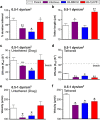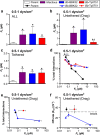Identification of Tp0751 (Pallilysin) as a Treponema pallidum Vascular Adhesin by Heterologous Expression in the Lyme disease Spirochete
- PMID: 28484210
- PMCID: PMC5431505
- DOI: 10.1038/s41598-017-01589-4
Identification of Tp0751 (Pallilysin) as a Treponema pallidum Vascular Adhesin by Heterologous Expression in the Lyme disease Spirochete
Abstract
Treponema pallidum subsp. pallidum, the causative agent of syphilis, is a highly invasive spirochete pathogen that uses the vasculature to disseminate throughout the body. Identification of bacterial factors promoting dissemination is crucial for syphilis vaccine development. An important step in dissemination is bacterial adhesion to blood vessel surfaces, a process mediated by bacterial proteins that can withstand forces imposed on adhesive bonds by blood flow (vascular adhesins). The study of T. pallidum vascular adhesins is hindered by the uncultivable nature of this pathogen. We overcame these limitations by expressing T. pallidum adhesin Tp0751 (pallilysin) in an adhesion-attenuated strain of the cultivable spirochete Borrelia burgdorferi. Under fluid shear stress representative of conditions in postcapillary venules, Tp0751 restored bacterial-vascular interactions to levels similar to those observed for infectious B. burgdorferi and a gain-of-function strain expressing B. burgdorferi vascular adhesin BBK32. The strength and stability of Tp0751- and BBK32-dependent endothelial interactions under physiological shear stress were similar, although the mechanisms stabilizing these interactions were distinct. Tp0751 expression also permitted bacteria to interact with postcapillary venules in live mice as effectively as BBK32-expressing strains. These results demonstrate that Tp0751 can function as a vascular adhesin.
Conflict of interest statement
The authors declare that they have no competing interests.
Figures





Similar articles
-
Identification of the Neuroinvasive Pathogen Host Target, LamR, as an Endothelial Receptor for the Treponema pallidum Adhesin Tp0751.mSphere. 2020 Apr 1;5(2):e00195-20. doi: 10.1128/mSphere.00195-20. mSphere. 2020. PMID: 32238570 Free PMC article.
-
Heterologous expression of the Treponema pallidum laminin-binding adhesin Tp0751 in the culturable spirochete Treponema phagedenis.J Bacteriol. 2008 Apr;190(7):2565-71. doi: 10.1128/JB.01537-07. Epub 2008 Feb 8. J Bacteriol. 2008. PMID: 18263731 Free PMC article.
-
Bifunctional role of the Treponema pallidum extracellular matrix binding adhesin Tp0751.Infect Immun. 2011 Mar;79(3):1386-98. doi: 10.1128/IAI.01083-10. Epub 2010 Dec 13. Infect Immun. 2011. PMID: 21149586 Free PMC article.
-
Role of outer membrane architecture in immune evasion by Treponema pallidum and Borrelia burgdorferi.Trends Microbiol. 1994 Sep;2(9):307-11. doi: 10.1016/0966-842x(94)90446-4. Trends Microbiol. 1994. PMID: 7812663 Review.
-
Treponema pallidum, the syphilis spirochete: making a living as a stealth pathogen.Nat Rev Microbiol. 2016 Dec;14(12):744-759. doi: 10.1038/nrmicro.2016.141. Epub 2016 Oct 10. Nat Rev Microbiol. 2016. PMID: 27721440 Free PMC article. Review.
Cited by
-
Syphilis vaccine: challenges, controversies and opportunities.Front Immunol. 2023 Apr 6;14:1126170. doi: 10.3389/fimmu.2023.1126170. eCollection 2023. Front Immunol. 2023. PMID: 37090699 Free PMC article. Review.
-
Priorities for sexually transmitted infection vaccine research and development: Results from a survey of global leaders and representatives.Vaccine X. 2021 Jun 29;8:100107. doi: 10.1016/j.jvacx.2021.100107. eCollection 2021 Aug. Vaccine X. 2021. PMID: 34401741 Free PMC article.
-
Identification and Functional Assessment of the First Placental Adhesin of Treponema pallidum That May Play Critical Role in Congenital Syphilis.Front Microbiol. 2020 Dec 21;11:621654. doi: 10.3389/fmicb.2020.621654. eCollection 2020. Front Microbiol. 2020. PMID: 33408711 Free PMC article.
-
Identification of the Neuroinvasive Pathogen Host Target, LamR, as an Endothelial Receptor for the Treponema pallidum Adhesin Tp0751.mSphere. 2020 Apr 1;5(2):e00195-20. doi: 10.1128/mSphere.00195-20. mSphere. 2020. PMID: 32238570 Free PMC article.
-
Immunization with a tri-antigen syphilis vaccine significantly attenuates chancre development, reduces bacterial load, and inhibits dissemination of Treponema pallidum.Vaccine. 2022 Dec 12;40(52):7676-7692. doi: 10.1016/j.vaccine.2022.11.002. Epub 2022 Nov 12. Vaccine. 2022. PMID: 36376214 Free PMC article.
References
-
- World Health Organization. Prevalence and incidence of selected sexually transmitted infections, Chlamydia trachomatis, Neisseria gonorrhoeae, syphilis and Trichomonas vaginalis: methods and results used by WHO to generate 2005 estimates (2011).
-
- Public Health Agency of Canada. Report on sexually transmitted infections in Canada: 2011. Available at: http://www.catie.ca/sites/default/files/64-02-14-1200-STI-Report-2011_EN... (Accessed: 22nd July 2015) (2014).
-
- Centers for Disease Control and Prevention. Sexually transmitted diseases surveillance 2013. Available at: http://www.cdc.gov/std/stats13/surv2013-print.pdf (Accessed: 22nd July 2015) (2014).
-
- Adriaenssens N, et al. European Surveillance of Antimicrobial Consumption (ESAC): outpatient macrolide, lincosamide and streptogramin (MLS) use in Europe (1997-2009) J. Antimicrob. Chemother. 2011;66(Suppl 6):vi37–45. - PubMed
Publication types
MeSH terms
Substances
Grants and funding
LinkOut - more resources
Full Text Sources
Other Literature Sources
Medical

